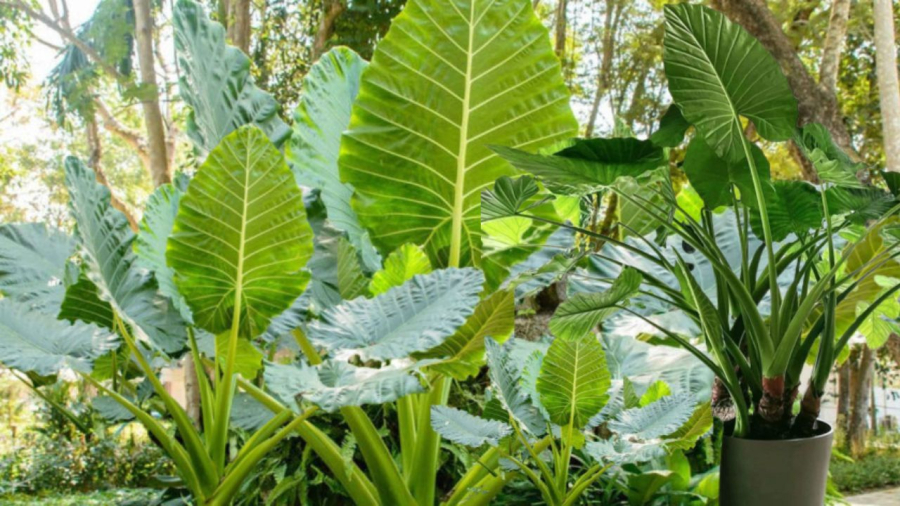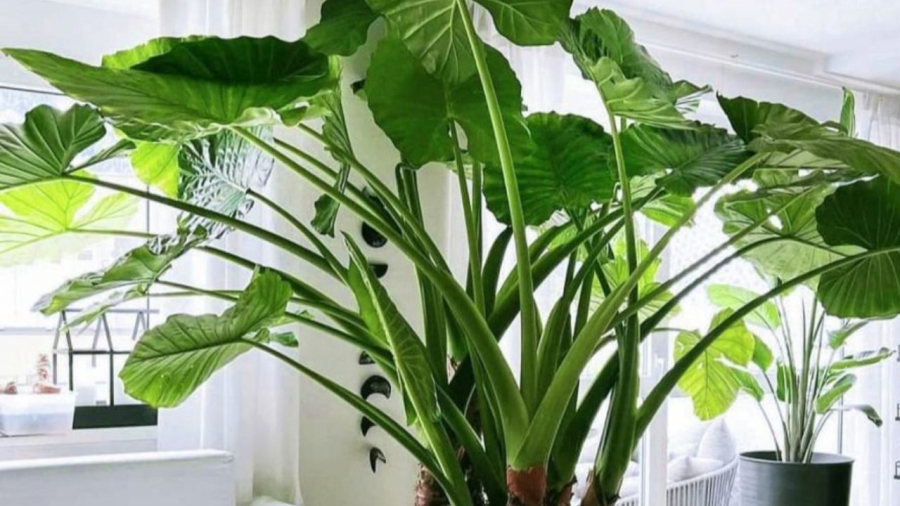In the world of ornamental plants, large-leafed, big-statured trees are now popular as they create a grand presence in the home.
In feng shui, large leaves are believed to attract wealth and bring good fortune. They represent strong yang energy, and a big, healthy tree signifies a powerful attraction of the earth’s energy. Thus, many large-leafed trees are highly regarded in feng shui today. One such tree that has gained attention recently is the Alocasia macrorrhizos, commonly known as the Elephant Ear plant, with its large, lush leaves and imposing stature.

Elephant Ear Plant – A Symbol of Good Luck and Prosperity
The Significance of the Elephant Ear Plant
The Elephant Ear plant is a wild-growing species often cultivated to attract wealth and luck. Its massive leaves, reaching the size of a human body, represent strong yang energy, absorbing abundant fortune from the heavens and the earth. The larger and greener the leaves, the more vibrant the plant, signifying increased luck, prosperity, and flourishing energy for the homeowner.
The size of the Elephant Ear plant’s leaves reflects the quality of its surrounding environment, indicating a healthy and thriving plant, which holds significant importance in feng shui. Favorable feng shui elements contribute to the plant’s vigorous growth. A robust and healthy Elephant Ear plant symbolizes successful development, good fortune, and abundant wealth. The plant’s grand stature also conveys the homeowner’s opulence, as caring for such a plant requires dedication and financial investment.
Additionally, the Elephant Ear plant is an excellent air purifier, naturally cleansing the air in your home. The large leaves represent a loving and prosperous family, caring for one another, with all members enjoying robust health.
In spacious homes, a sizeable Elephant Ear plant creates a sense of balance and harmony with the architectural design.

A Large Statured Plant Creates a Grand Presence in the Home
How to Grow a Large Elephant Ear Plant
The Elephant Ear plant is a resilient and vigorous species. It thrives in warm temperatures and can be moved indoors during colder seasons, then outdoors again in the spring. You can propagate this plant through division or by planting its bulbs.
Light: When growing the Elephant Ear plant, pay attention to its light requirements. While it prefers bright, indirect light or partial shade, providing more light will result in darker, richer foliage.
Soil: In nature, this plant is not picky about soil type, but when grown in pots for decorative purposes, use well-drained, nutrient-rich soil for optimal growth.
Water: While the Elephant Ear plant tolerates moisture, when grown indoors, maintain slightly moist soil to prevent mosquitoes and other pests. Avoid overwatering, but do not let the soil dry out completely, as the plant does not tolerate drought.
Temperature: This plant thrives in tropical climates and will go dormant in cold temperatures, regrowing the following year.
Fertilizer: Like many tropical plants with large leaves, the Elephant Ear plant is a heavy feeder. Fertilize it with nitrogen-rich fertilizer dissolved in water every two to three weeks.
For reference only
2023 Lunar New Year Gift Ideas for Older Family and Friends
As 2021 approaches, families worldwide are gathering to celebrate the special bond between grandparents and their grandchildren. To show their love and admiration, these thoughtfully chosen gifts will bring a smile to the face of the elderly. Here, we have compiled a list of the 13 most meaningful Tet presents that can bring joy to our beloved grandparents.



































